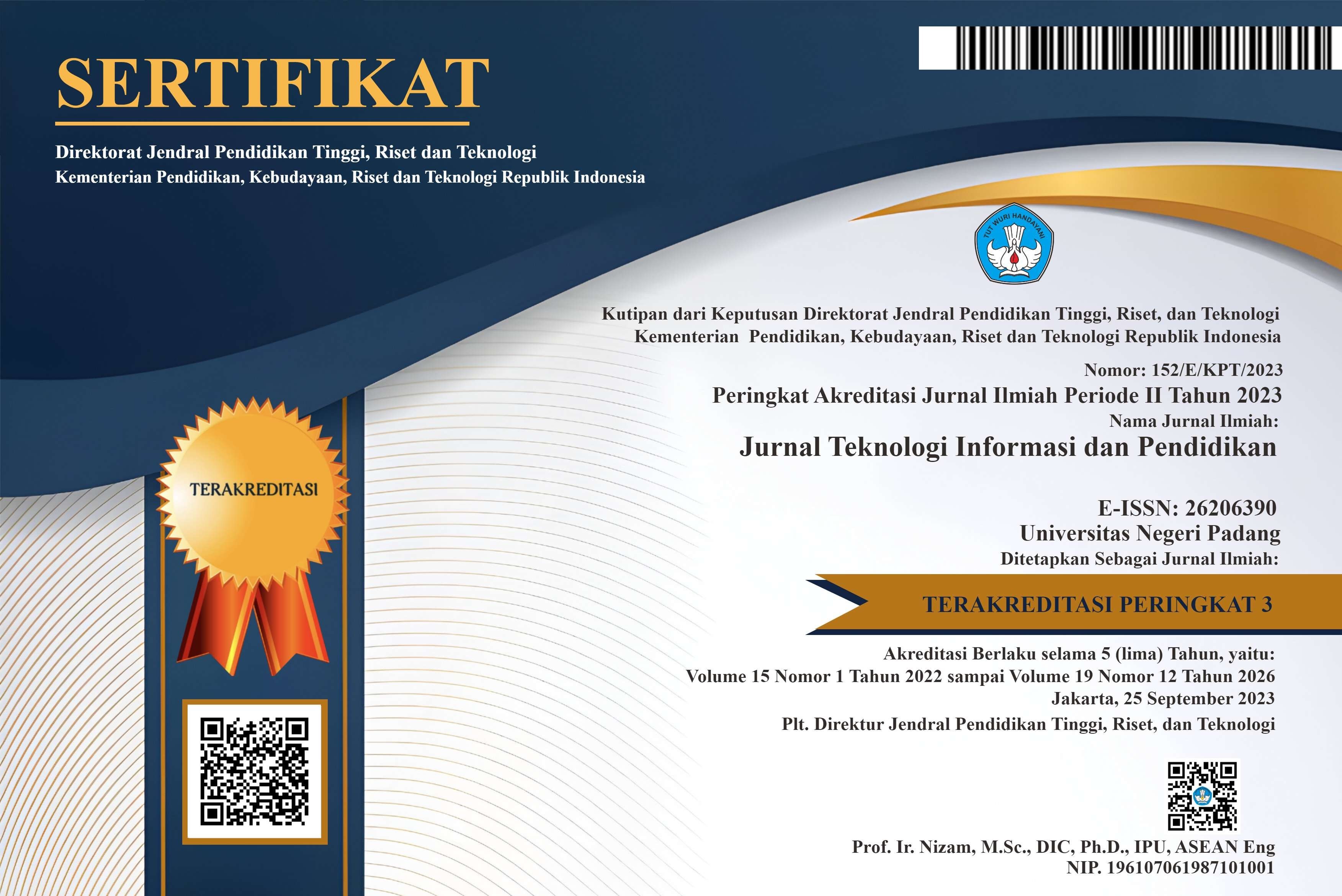Computer-based Learning Model in Early Schools During the Covid-19 Pandemic in Rural Areas
Abstract
The COVID-19 pandemic has affected many aspects of life. In education, the conventional learning process has drastically changed to online. Schools with good resources and infrastructure, of course, can quickly adapt. However, schools with limited infrastructure, as well as low teacher skills, are a challenge. This research is to study the implementation of e-learning in online kindergarten classes from the existing conditions, challenges, and learning strategies that will be applied in PAUD schools in Jayapura City. The results of this study can be used as a reference in making decisions for implementing more effective online learning at the PAUD level. To gather data, a survey was conducted among 20 kindergarten and early childhood teaching staff in Jayapura City using a combination of methods, including contacting the schools, WhatsApp, and Google Forms. The findings reveal that the kindergarten-level teaching staff are predominantly women, aged between 24 and 54 years, with the majority falling within the age range of 35-53 years. The study also highlights the importance of e-learning in the current pandemic, as it enables teachers to document the educational process, remain organized, and provide more effective support to students amid distance restrictions and other challenges. The study results show that e-learning is essential to be prepared, especially during a pandemic. The willingness to engage in e-learning can help teachers document the educational process, be more organized, and be more helpful to students amid distance restrictions and other effects. However, teachers still need training to improve skills related to digital literacy. The training is more on multimedia to support learning and create exciting learning content with Multimedia.
References
A. Buana and U. Linarti, “Measurement of Technology Acceptance Model (TAM) in Using E-Learning in Higher Education,” J. Teknol. Inf. dan Pendidik., vol. 14, no. 2, pp. 165–171, 2021, doi: 10.24036/jtip.v14i2.471.
N. T. Martoredjo, “Pandemi Covid-19: Ancaman atau Tentangan bagi Sektor Pendidikan?,” J. Pendidik., vol. 2, no. 1, pp. 1–15, 2020, [Online]. Available: https://core.ac.uk/download/pdf/328807842.pdf.
E. M. Onyema, F. Obafemi, S. Sen, and A. Sharma, “Impact of Coronavirus Pandemic on Education,” J. Educ. Pract., no. June, 2020, doi: 10.7176/jep/11-13-12.
UNESCO, “COVID-19: Laporan baru UNICEF mengungkap setidaknya sepertiga anak sekolah di seluruh dunia tidak dapat mengakses pembelajaran jarak jauh selama sekolah ditutup,” 2020. https://www.unicef.org/indonesia/id/press-releases/covid-19-laporan-baru-unicef-mengungkap-setidaknya-sepertiga-anak-sekolah-di-seluruh (accessed Feb. 25, 2022).
S. N. Botutihe, M. Bin Smith, I. A. Kasan, and R. Hilala, “Strategi Pembelajaran Physical Distancing Guru PAUD dalam Menghadapi Pandemi Covid19,” J. Obs. J. Pendidik. Anak Usia Dini, vol. 5, no. 2, pp. 1536–1543, 2020, doi: 10.31004/obsesi.v5i2.919.
Kementerian Pendidikan dan Kebudayaan, Kepmendikbud Nomor 719/P/2020 tentang Pedoman Pelaksanaan Kurikulum pada Satuan Pendidikan dalam Kondisi Khusus. 2020, p. 9.
N. Nurdin and L. Anhusadar, “Efektivitas Pembelajaran Online Pendidik PAUD di Tengah Pandemi Covid 19,” J. Obs. J. Pendidik. Anak Usia Dini, vol. 5, no. 1, p. 686, 2020, doi: 10.31004/obsesi.v5i1.699.
A. D. Samala, B. R. Fajri, F. Ranuharja, and R. Darni, “Pembelajaran Blended Learning Bagi Generasi Z di Era 4.0,” J. Teknol. Inf. dan Pendidik., vol. 13, no. 1, pp. 45–53, 2020, doi: https://doi.org/10.24036/tip.v13i1.
A. M. Basar, “Problematika Pembelajaran Jarak Jauh Pada Masa Pandemi Covid-19,” Edunesia J. Ilm. Pendidik., vol. 2, no. 1, pp. 208–218, 2021, doi: 10.51276/edu.v2i1.112.
T. T. Mukarromah and P. Agustina, “Gamifikasi Berbasis Aplikasi dan Pembelajaran Anak Usia Dini,” EDUKIDS J. Pertumbuhan, Perkembangan, dan Pendidik. Anak Usia Dini, vol. 18–27, no. 1, p. 18, 2021, doi: 10.17509/edukids.v18i1.33338.
R. M. Kmurawak and S. A. Mandowen, “Pengukuran Tingkat Kesiapan E-learning Guru di Kota Jayapura di Masa Pandemic Covid-19,” Techno.Com, vol. 20, no. 4, pp. 518–526, 2021, doi: 10.33633/tc.v20i4.5168.
N. Karniawati and G. M. Rani, “E-learning in Online Education Game For Kids,” J. Teknol. Inf. dan Pendidik., vol. 13, no. 2, pp. 37–40, 2020, doi: https://doi.org/10.24036/tip.v13i1.
F. N. Arifa, “Tantangan pelaksanaan kebijakan belajar dari rumah dalam masa darurat covid-19,” Info Singk. Kaji. Sing. terhadap Isu Aktual dan Strateg., vol. 7, no. 1, pp. 13–18, 2020.
R. M. Kmurawak, S. A. Mandowen, S. I. Beno, P. D. Lokollo, and H. Tobing, “Measuring the E-learning Readiness Level in Rural Areas During the Covid-19 Pandemic,” J. Educ. Technol., vol. 6, no. 3, pp. 459–466, 2022.
A. Andersson and Å. Grönlund, “A Conceptual Framework for E-Learning in Developing Countries: A Critical Review of Research Challenges,” Electron. J. Inf. Syst. Dev. Ctries., vol. 38, no. 1, pp. 1–16, 2009, doi: 10.1002/j.1681-4835.2009.tb00271.x.
F. Martin, K. Budhrani, and C. Wang, “Examining faculty perception of their readiness to teach online,” Online Learn. J., vol. 23, no. 3, pp. 97–119, 2019, doi: 10.24059/olj.v23i3.1555.
D. Napitupulu, K. Adiyarta, D. Abdullah, and D. Murtiningsih, “Proposed ELR Model for E-Learning Readiness Evaluation Based on McKinsey 7S Framework,” in ICASI, 2019, no. 6, doi: 10.4108/eai.18-7-2019.2288544.
A. Saekow and D. Samson, “E-learning Readiness of Thailand’s Universities Comparing to the USA’s Cases,” Int. J. e-Education, e-Business, e-Management e-Learning, vol. 1, no. 2, 2011, doi: 10.7763/ijeeee.2011.v1.20.
A. Ate, S. Zaineldeenc, C. Zhaohui, and Y. Zhao, “Assessing the E-learning Readiness of Universities in Developing Countries and Expected Obstacles,” Makara J. Technol., vol. 25, no. 3, 2021, doi: 10.7454/mst.v25i3.4047.
C. H. Aydin and D. Tasci, “Measuring readiness for e-learning: Reflections from an emerging country,” Educ. Technol. Soc., vol. 8, no. 4, pp. 244–257, 2005.
C. T. Lopes, “Evaluating e-learning readiness in a health sciences higher education institution,” Proc. IADIS Int. Conf. e-Learning, EL 2007 - Part IADIS Multi Conf. Comput. Sci. Inf. Syst. MCCSIS 2007, vol. 1, no. July, pp. 59–67, 2007.
S. Chapnick, “Are You Ready for E-Learning?” 2000. https://nurhadiw.files.wordpress.com/2010/08/are_you_ready_for_elearning.pdf.
A. A. Mosa, M. Naz’ri bin Mahrin, and R. Ibrahim, “Technological Aspects of E-Learning Readiness in Higher Education: A Review of the Literature,” Comput. Inf. Sci., vol. 9, no. 1, p. 113, 2016, doi: 10.5539/cis.v9n1p113.
C. Machado, “Developing an e-readiness model for higher education institutions: Results of a focus group study,” Br. J. Educ. Technol., vol. 38, no. 1, pp. 72–82, 2007, doi: 10.1111/j.1467-8535.2006.00595.x.
K. Kaur and Z. W. Abas, “An assessment of e-learning readiness at Open University Malaysia.,” in International Conference on Computers in Education., 2004, vol. 88, no. 2, pp. 231–233, doi: 10.1016/0014-5793(78)80181-1.
Copyright (c) 2024 Jurnal Teknologi Informasi dan Pendidikan

This work is licensed under a Creative Commons Attribution-ShareAlike 4.0 International License.















.png)














